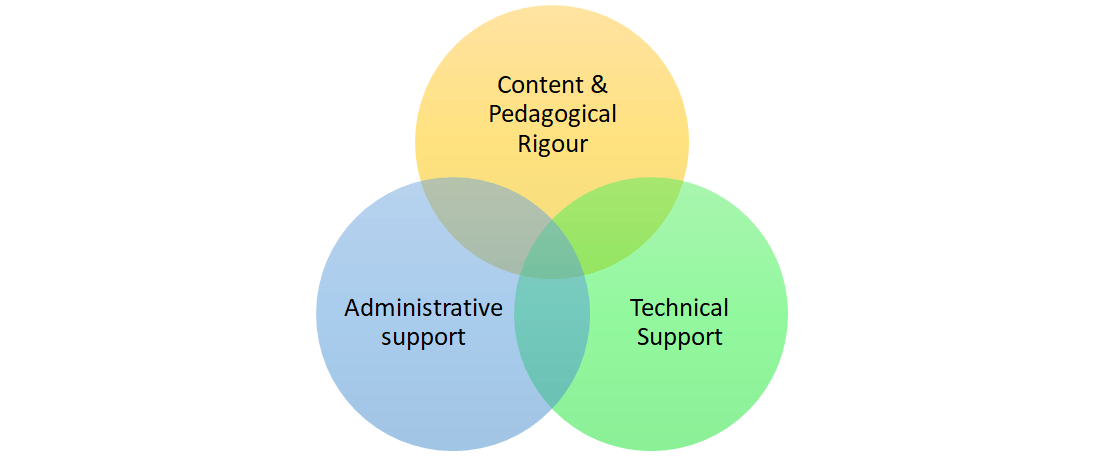Aileen LAM, Jodie LUU, and Sylvia SIM
Centre for English Language Communication (CELC)
Informed by their experience of developing the MOOC “Intercultural Communication at Work–Land the Job & Do it Well”, the authors curate a list of questions colleagues can consider before they embark on developing a similar online course.

Lam, W. A., Luu, T. H. L., & Sim, S. C. S. (2021, Sept 25). 8 questions to think about when developing a MOOC. Teaching Connections. https://blog.nus.edu.sg/teachingconnections/2021/09/25/8-questions-to-think-about-when-developing-a-mooc/
Educational institutions have increasingly leveraged massive open online courses (MOOCs) to not only enhance their visibility and branding (Hollands & Tirthali, 2014), but also to create an avenue for educators to develop professionally (Stöhr et al., 2015) in terms of online curriculum design and pedagogical approaches.
Drawing from a collaborative framework of MOOC development (Lam et al., 2020) (Figure 1), which was developed based on our experience with conceptualising and formulating one of the first four NUS MOOCs on edX (NUS News, 2019), we propose some practical questions that might be useful for your MOOC development endeavour.

Content and Pedagogy
Qn 1: How would you conceptualise your MOOC?
You need to consider your MOOC’s unique selling point compared with other similar online courses, and then align it with your expertise as well as learners’ needs. This would help you set clearer course objectives and syllabus, which in turn helps entice learners to sign up for your course.
Qn 2: How would you organise the course content online?
MOOC learners tend to engage in self-directed and selective learning by choosing topics aligned with their personal interest and motivation (Kizilcec et al., 2013; Jacobsen, 2019). Hence, the content needs to be clearly demarcated into topics/units to facilitate selective learning. A synopsis can be provided at the start of each unit to direct learners.
Qn 3: How would you deliver the course content and facilitate online interaction?
Online course materials typically include readings, notes, and lecture videos. However, MOOC developers may need to do more to facilitate online interaction. According to Moore (1989; 1993), it is helpful to consider the transactional distance, defined as the space and time separating the learner from the content, instructor, and other learners online (Figure 2).
When designing MOOC materials and activities (e.g. videos, interactive pdfs, online discussions, peer reviews, learning communities, social spaces), consider the software tools that facilitate learner-content, learner-instructor and learner-learner interaction.

Technical Support
Qn 4: What are the available forms of video production support?
Beyond scripting and visualisation, you need access to studio recording facilities and/or an outdoor filming crew to handle the outdoor filming, sound, and lighting. You will also need post-production support to edit the raw footage. This involves trimming, mending, adding visuals, texts and animations, and converting the footage to a recognisable multimedia file.
Qn 5: What are the affordances of the platform/learning management system (LMS) for your MOOC?
You may need to consider the limits of the platform/LMS utilised by your institution and ensure that it can support your MOOC activities. For example, not all platforms offer the full range of question options for quizzes (e.g. multiple choice, True/False, ranking, matching, Likert scales), or have the capability to support peer review activities. It is also worth checking whether widgets can be added to customise your desired interactive learning experiences.
Qn 6: What are the available forms of platform management support?
You will need logistical support in terms of setting the start/end dates, determining the pricing, uploading videos and creating other learning activities on the learning platform (e.g. edX, Coursera). In our case, our colleague from the Centre for Instructional Technology (CIT) helped us add widgets for some interactive activities, manage the assessments, and retrieve completion data.
Administrative Support
Qn 7: Do you have the support and budget to produce and maintain the MOOC?
Creating an effective MOOC requires extensive planning and resources. It requires time (Sneddon et al., 2018), work (Bartoletti, 2016), and money (Haywood & Macleod, 2014; Kopp et al., 2014). Some points to consider:
- Be realistic about your work commitments. You may want to negotiate your workload with your home department before developing your MOOC. Then consider how your MOOC can be funded. Applying to an institutional funding body, such as the Learning Innovation Fund–Technology (LIFT) in NUS, is one option.
- Collaboration is key. We worked extensively with other departments to produce the lecture, scenario and interview videos for the MOOC (Table 1).

Qn 8: Are your content and videos free from copyright and intellectual property infringement?
The open nature of MOOCs entails many legal implications. Besides duly citing all sources, you need to ensure that all content, including wordings, diagrams, images, audio files and video clips do not infringe copyright or intellectual property right rules. The legal department of your institution may offer guidance in this matter.
 |
Aileen LAM Wanli is from the Centre for English Language Communication (CELC) in NUS and has more than ten years of teaching and corporate training experience in communications and media. She is passionate about the use of technology in education, and has developed online and blended courses in NUS. Aileen can be reached at aileenlam@nus.edu.sg |
 |
Jodie LUU is a lecturer at CELC. She is passionate about harnessing the power of digital technologies to create an inclusive, interactive and learner-centred classroom. Having taught a flipped module and co-developed online courses for both the NUS community and global learners (edX), she is also interested in research on pedagogy for MOOCs and blended learning. Jodie can be reached at jodieluu@nus.edu.sg. |
 |
Sylvia SIM is a lecturer at CELC and has taught language and communication skills for more than twenty years. Having designed and taught blended and MOOC modules for local and global learners, she believes that technology can greatly enhance course design to give students an engaging and effective learning experience. Sylvia can be reached at elcsimsc@nus.edu.sg. |
References
Bartoletti, R. (2016). Learning through design: MOOC development as a method for exploring teaching methods. Current Issues in Emerging eLearning, 3(1), 2. https://scholarworks.umb.edu/ciee/vol3/iss1/2/
Haywood, J., & Macleod, H. (2014). To MOOC or not to MOOC? University decision-making and agile governance for educational innovation. In Massive Open Online Courses (pp. 56-70). Routledge.
Hollands, F. M., & Tirthali, D. (2014). Resource requirements and costs of developing and delivering MOOCs. International Review of Research in Open and Distributed Learning, 15(5), 113-133. https://doi.org/10.19173/irrodl.v15i5.1901
Jacobsen, D. Y. (2019). Dropping out or dropping in? A connectivist approach to understanding participants’ strategies in an e-learning MOOC pilot. Technology, Knowledge and Learning, 24(1), 1-21. http://dx.doi.org/10.1007/s10758-017-9298-z
Kizilcec, R., Piech, C., & Schneider, E. (2013, April 8-12). Deconstructing disengagement: Analyzing learner subpopulations in massive open online courses [Conference presentation]. LAK’13 Leuven, Belgium. https://web.stanford.edu/~cpiech/bio/papers/deconstructingDisengagement.pdf
Kopp, M., Ebner, M., & Dorfer-Novak, A. (2014). Introducing MOOCs to Austrian universities. INNOQUAL-International Journal for Innovation and Quality in Learning, 2(3), 46-52. https://unipub.uni-graz.at/obvugroa/download/pdf/366958?originalFilename=true
Lam, W. A., Luu, T. H. L., & Sim, S. C. S. (2020, December 8-9). Beyond pedagogy: Factors to consider for MOOC development [Conference presentation]. Online Higher Education Campus Conference (e-HECC) 2020, Centre for Development of Teaching & Learning, National University of Singapore.
Moore, M. G. (1989) Editorial: Three types of interaction. American Journal of Distance Education, 3(2), 1-7, http://dx.DOI.org/10.1080/08923648909526659
Moore, M. G. (1993). Theory of transactional distance. In D. Keegan (Ed). Theoretical principles of distance education. London; New York: Routledge. Retrieved from https://www-taylorfrancis-com.libproxy1.nus.edu.sg/books/9780203983065.
NUS News (2019, November 14). NUS partners with global online course provider edX to expand its suite of courses. NUS News. https://news.nus.edu.sg/press-releases/NUS-partners-edX-expand-MOOCs
Sneddon, J., Barlow, G., Bradley, S., Brink, A., Chandy, S. J., & Nathwani, D. (2018). Development and impact of a massive open online course (MOOC) for antimicrobial stewardship. Journal of Antimicrobial Chemotherapy, 73(4), 1091-1097. https://doi.org/10.1093/jac/dkx493
Stöhr, C., Eriksson, T., & Adawi, T. (2015, June 11-12). Reasons for engaging in MOOC development: Management, faculty and support perspectives [Conference poster]. MOOCs in Scandinavia Conference, Stockholm, Sweden. https://research.chalmers.se/en/publication/254419

